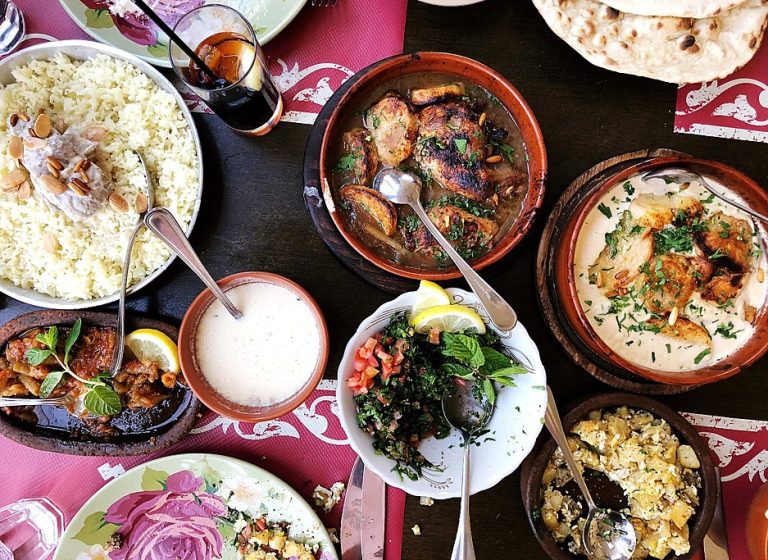- Jordanian Cuisine
- Andy Nurse

Top 5 Foods You Need to Try When You’re in Jordan
A Guide to the Food and Drink of Jordan.
At the centre of the ancient world, Jordan has always been a place at which cultures have collided. And sat upon trade routes that linked the Mediterranean with India and Persia – and Africa with Arabia – it has, over time, reaped the benefits of all this cultural contact.
Look no further for proof than Jordanian cuisine, which borrows from and embellishes dishes from the length of the Old World.
Whilst you’ll probably know already about falafel (originally Egyptian) and shawarma (originally Turkish), that’s not even the start. Jordanian food and drink – like that of the Middle East in general – is as rich and diverse as it is gorgeously tasty. And it’s fundamentally social, so be prepared to share.
Here are some of our suggestions for the different food to try in Jordan.
1. Mansaf – Jordan’s National Dish.
Mansaf is the centrepiece of Jordanian cuisine – and the country’s national dish.
Traditionally a Bedouin dish, mansaf is made of lamb cooked in a broth of jameed – a dense and dry fermented yoghurt – and dished up on flatbread. Served with rice, parsley, pine nuts, and more jameed, it makes quite a considerable meal.
The word mansaf means ‘large dish’. And, traditionally, you’d share it from a communal plate – with your right hand only.
This is one of the essential foods you need to try when you’re in Jordan.
2. Mezze.
Whilst mansaf functions as a ceremonial meal – eaten on national holidays, for example – mezze is the normal Jordanian way of eating. Often compared to Spanish tapas, mezze is all about the small plate (it comes from the word meaning ‘to taste’ in Persian). And it’s excellent for vegetarians and vegans.
Sharing is the name of the game – and it’s here that you’ll find all the classics of Middle Eastern cuisine:
- Hummus, your classic chickpea and tahini dip;
- Mutabbal, an aubergine dip with tahini and mint;
- Tabbouleh, a salad of parsley, bulgur wheat, mint, tomatoes and onion;
- Baba ghanoush, a dip of mashed aubergine;
- Ful medames, a fava bean stew with oil and cumin.
Expect plenty of bread too, including pita and khobz, a round flatbread.
3. Jordan’s Street Food: Falafel, Shawarma, Manaqeesh.
One of the joys of wandering around Middle Eastern towns like Amman is the street food. In Jordan, they do it incredibly, incredibly well.
Balls of ground chickpeas and spices that are then deep fried, falafel have become a hit in the west for a reason. And western falafel pales in comparison to even the worst you’ll find in Jordan. Eat it in a sandwich at any time of the day. We don’t need to tell you that this is the food to try in Jordan.
From the days when the Ottomans ruled Jordan, shawarma is that meat shaved from rotating spits. Served in pita with whatever toppings you fancy.
Often referred to as the Middle Eastern pizza, manaqeesh is a flatbread served with a variety of toppings. Halloumi and egg is a popular one, but the classic is simply with oil and za’atar, the mixture of spices – thyme, oregano, sumac, and others – that you’ll taste everywhere in Jordan.
4. The Jordanian Breakfast.
Breakfast in Jordan, as with everywhere else in the world, varies with region, person, and taste.
Usually, you’ll find eggs, olives, cheese, and ful medames. Labneh is also a staple. It’s a thick yoghurt you spread onto plentiful bread.
But, for breakfast, Jordanians eat anything from falafel to baklava – the tooth-crackingly sweet Ottoman dessert. You’re sure to find a Jordanian breakfast you love.
5. Drinking Jordanian-Style.
It’s hard not to finish a meal in Jordan without drinking a cup of tea. This is served black and sweet, and flavoured with either sage or mint. You’ll be drinking gallons of this in any Bedouin camp you visit, like those around Petra.
Coffee is ubiquitous too. The Bedouins will serve you Arabic coffee, usually with cardamom. The rest of the time you’ll find Turkish coffee: strong as hell, thick and opaque.
Arak is the alcoholic drink of choice, traditionally made of only two ingredients: grapes and aniseed. You’ll recognise it because it is translucent and white. Just a note of caution: when it’s homemade, it can be really, really strong.

